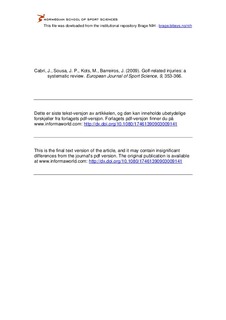| dc.contributor.author | Cabri, Jan | |
| dc.contributor.author | Sousa, João Paulo | |
| dc.contributor.author | Kots, Magdalena | |
| dc.contributor.author | Barreiros, João | |
| dc.date.accessioned | 2010-11-01T14:00:56Z | |
| dc.date.available | 2010-11-01T14:00:56Z | |
| dc.date.issued | 2009-11 | |
| dc.identifier | Seksjon for fysisk prestasjonsevne / Department of Physical Performance | |
| dc.identifier.citation | European Journal of Sport Science. 2009, 9(6). 353-366 | en_US |
| dc.identifier.issn | 1746-1391 | |
| dc.identifier.uri | http://hdl.handle.net/11250/170577 | |
| dc.description | I Brage finner du siste tekst-versjon av artikkelen, og den kan inneholde ubetydelige forskjeller fra forlagets pdf-versjon. Forlagets pdf-versjon finner du på www.informaworld.com: http://dx.doi.org/10.1080/17461390903009141 / In Brage you'll find the final text version of the article, and it may contain insignificant differences from the journal's pdf version. The original publication is available at www.informaworld.com: http://dx.doi.org/10.1080/17461390903009141 | en_US |
| dc.description.abstract | A review was undertaken to assess the prevalence of musculoskeletal injuries in golf and to stimulate the discussion on possible injury mechanisms. The main conclusion of most published studies is that although professional and amateur golfers show a similar anatomical distribution of injuries by body segment, differences tend to be seen in the ranking of injury occurrence by anatomical site. This could be due to many things, including the player's handicap, age, golf swing biomechanics, and training or playing habits. The impact of golf injuries deserves special attention due to the interaction of the nature of the injury, practice routines, amount of practice, handicap, and frequency of activity. Individual differences and clinical and coaching procedures deserve investigation. Other epidemiological information should be regarded as insufficient with respect to a full understanding of injury mechanisms, which can give us a better insight into the evolutionary nature of the injury. Also, a better understanding of golf swing mechanisms and individual neuromuscular aspects can help explain why some individuals are more injury-prone than others. | en_US |
| dc.language.iso | eng | en_US |
| dc.publisher | Taylor & Francis | en_US |
| dc.subject | golf | |
| dc.subject | injuries | |
| dc.subject | injury mechanisms | |
| dc.title | Golf-related injuries: a systematic review | en_US |
| dc.type | Journal article | en_US |
| dc.type | Peer reviewed | en_US |
| dc.subject.nsi | VDP::Social science: 200::Social science in sports: 330::Other subjects within physical education: 339 | en_US |
| dc.source.pagenumber | 353-366 | en_US |
